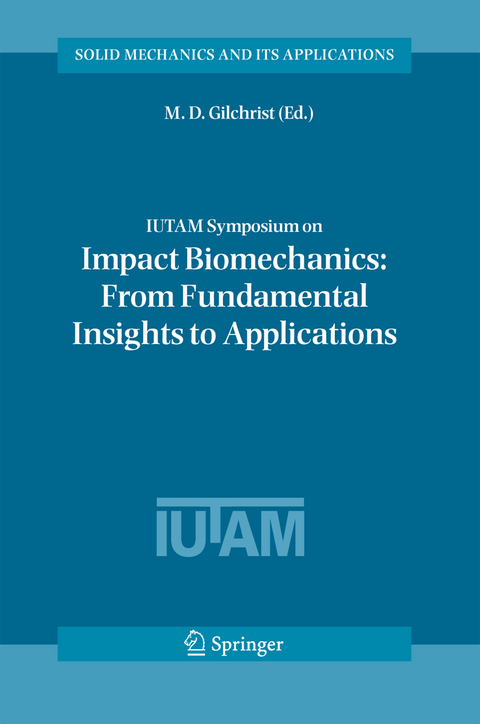IUTAM Symposium on Impact Biomechanics: From Fundamental Insights to Applications
Springer-Verlag New York Inc.
978-1-4020-3795-5 (ISBN)
Substantialfundamental workhas been undertaken inthe different aspects of impact biomechanics over the past three decades. Much of this has been motivated and undertaken bythe automotive industry intheirefforts to improve transport safety. More recently, however, it has become app- ent that themultidisciplinary synergies which are realisedby interactions between engineers, scientists and clinical practitioners will ultimately lead to a greater understanding of the complex interacting phenomena withinthe human bodyafter it has sustained an impact. In turn, this greater depth of knowledge will provide more fundamentalinsights into the analysis, d- gnosis, treatment and prevention ofimpact injuries across a broader sp- trum of accident environments. Thescienti?c focus of this IUTAM symposium istoaddress those t- ics that are centrally important to the biomechanics ofimpact. These can be groupedinto those that are concerned with the different causes of - cidents (e. g. , transport, occupational and sports injuries), themechanics - volvedinaccident analysis (e. g.
, accident investigation, computational m- elling techniques), the different types of resulting traumatic injuries (incl- ing musculoskeletal, organ, spinal and head injuries), methods of asse- ing the extent of injury (e. g. , injury assessment, injury criteria, constitutive laws for human tissue), and providing protection during an impact (e. g. , injury prevention, energy absorption materials, and safety devices).
Session 1.- The Contribution of Accident Investigation Research to Biomechanics.- Modeling the Effects of Blast on the Human Thorax Using High Strain Rate Viscoelastic Properties of Human Tissue.- Preliminary Analysis of Blunt Ballistic Impacts to the Abdomen.- Development of an Assessment Methodology for Lower Leg Injuries Resulting from Anti-Vehicular Blast Landmines.- Occupant Lower Leg Injury Assessment in Landmine Detonations under a Vehicle.- The Simulated Response of Cortical and Cancellous Bone to Various Rates of Loading — A Preliminary Numerical Study.- Session 2.- Multibody Dynamics Approaches for Biomechanical Modeling in Human Impact Applications.- Reconstructing Real Life Accidents Towards Establishing Criteria for Traumatic Head Impact Injuries.- Combined Multi-Body Dynamic and FE Models of Human Head and Neck.- Three Years Old Child Neck Finite Element Modelisation.- Response Analysis of Lumbar Vertebra Model under Axial Impact Loading.- Session 3.- Head Impact Biomechanics in Sport.- Biofidelity of Dummy and FEM Necks in the Frequency Domain.- Influence of Helmet Inertial Properties on Neck Injury Risk During Ejection: A Numerical Human Model Approach.- Quasi-Analytic Acceleration Injury Risk Functions: Application to Car Occupant Risk in Frontal Collisions.- Modelling of Frontal Collisions from Onboard Recorder and Full Width Barrier Data.- Accidents of Motorcyclists Against Roadside Infrastructure.- Session 4.- Biomechanical Aspects of Blunt and Penentrating Head Injuries.- Biomechanics of Frontal Skull Fracture.- Numerical Modeling of the Human Head under Impact: New Injury Mechanisms and Tolerance Limits.- Mechanisms and Tolerance Curves of Traumatic Diffuse Axonal Injury (DAI).- Sensory Disorders of the Auditory and Vestibular Systems FollowingBlunt Head Trauma.- Biomechanical, Radiographic and Osteologic Observations of Lower Cervical Spine Injuries.- Session 5.- Impact Injury in Sport.- Clinical and Biomechanical Research for Bicycle Helmet Optimisation.- Application of Finite Element Analysis to Helmet Design.- Finite Element Modeling for the Prediction of Blast Trauma.- Evaluation of Human Head Injury in Tracked Vehicle Subjected to Mine Blast.- Finite Volume Solution to High Rate Wave Propagation Through a Lung Alveoli Stack.- Session 6.- Cellular Basis for the Nonlinear Constitutive Properties of Brain Tissue.- Cerebral Bridging Vein Rupture in Humans.- Three Dimensional Passive Properties of Muscle Tissue in Compression.- A National Review of Surgically Treated Blunt Traumatic Thoracic Aortic Transections.- Lack of Consistency in Threat to Life from Single Injury Abbreviated Injury Scale (AIS) 4 Codes in Different Body Areas.- Session 7.- Mechanical Factors in Osteoarthrosis.- The Initial Assessment and Management of Blunt Trauma.- Bioengineering and Orthopaedic Surgery in Practice.- The Impact Biomechanics of Spinal Column Injuries.- Brain Oedema and Intracranial Pressure.- Traumatic Brain Injury.- A Selective Depolarisation-Induced Increase in Excitatory Amino Acid Neurotransmitter Release in Rat Medial Prefrontal Cortex Using a Microdialysis Model of Traumatic Brain Injury.- Victims of Penetrating and Incised Wounds.- Session 8.- Computational Human Body Models.- Reconstruction of Head Injury Cases Arising from Falls Using the UCD Brain Trauma Model.- Numerical Human Model to Predict Side Impact Thoracic Trauma.- Numerical Simulation of Shoulder Response to a Lateral Impact with the HUMOS Model.- Finite Element Model of Human Skull Used for Head Injury Criteria Assessment.- A Computational Study ofthe Optic Nerve Evulsion.- An Anisotropic Viscous Hyperelastic Constitutive Model of the Posterior Cruciate Ligament Suitable for High Loading Rate Situations.
| Erscheint lt. Verlag | 30.6.2005 |
|---|---|
| Reihe/Serie | Solid Mechanics and Its Applications ; 124 |
| Zusatzinfo | XV, 489 p. |
| Verlagsort | New York, NY |
| Sprache | englisch |
| Themenwelt | Mathematik / Informatik ► Mathematik ► Wahrscheinlichkeit / Kombinatorik |
| Medizin / Pharmazie ► Medizinische Fachgebiete ► Chirurgie | |
| Medizin / Pharmazie ► Medizinische Fachgebiete ► Notfallmedizin | |
| Technik ► Maschinenbau | |
| ISBN-10 | 1-4020-3795-3 / 1402037953 |
| ISBN-13 | 978-1-4020-3795-5 / 9781402037955 |
| Zustand | Neuware |
| Haben Sie eine Frage zum Produkt? |
aus dem Bereich




